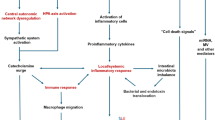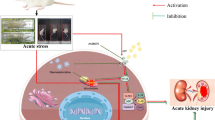Abstract
The iron chelator, deferoxamine mesylate (DFO), has shown neuroprotective effects, mediated via suppression of iron-induced hydroxyl radical formation, in various animal models of ischemic and hemorrhagic stroke. Therefore, the objective of this study was to investigate whether DFO can exert similar actions in stroke patients, by examining the effects of treatment with DFO on biological markers of oxidative stress, namely serum total hydroperoxides and lipoperoxides and total radical trap** antioxidant capacity (TRAP), in stroke patients. We found that serum levels of peroxides were reduced, and TRAP levels increased after a 3-day treatment with DFO (500 mg). These findings provide a preliminary proof of concept that DFO can exert potential antioxidant neuroprotective effects in stroke patients. Future, larger-scale, randomized, and controlled studies to further evaluate the safety and efficacy of DFO in patients with stroke are warranted.

Similar content being viewed by others
References
Kondo Y, Asanuma M, Nishibayashi S, Iwata E, Ogawa N (1997) Late-onset lipid peroxidation and neuronal cell death following transient forebrain ischemia in rat brain. Brain Res 772(12):37–44
Ishimaru H, Ishikawa K, Ohe Y, Takahashi A, Tatemoto K, Maruyama Y (1996) Activation of iron handling system within the gerbil hippocampus after cerebral ischemia. Brain Res 726(1–2):23–30
Palmer C, Menzies S, Roberts R, Pavlick G, Connor J (1999) Changes in iron histochemistry after hypoxic–ischemic brain injury in the neonatal rat. J Neurosci Res 56:60–71
Huang FP, ** G, Keep RF, Hua Y, Nemoianu A, Hoff JT (2002) Brain edema after experimental intracerebral hemorrhage: role of hemoglobin degradation products. J Neurosurg 96:287–293
Koeppen AH, Dickson AC, McEvoy JA (1995) The cellular reactions to experimental intracerebral hemorrhage. J Neurol Sci 134(Supl):102–112
Bishop G, Robinson S (2001) Quantitative analysis of cell death and ferritin expression in response to cortical iron: implications for hypoxia–ischemia and stroke. Brain Res 907(1–2):175–187
Winterbourn C (1995) Toxicity of iron and hydrogen peroxide: the Fenton reaction. Toxicol Lett 82:969–974
Palmer C, Roberts R, Bero C (1994) Deferoxamine posttreatment reduces ischemic brain injury in neonatal rats. Stroke 25:1039–1045
Patt A, Horesh R, Berger M, Harken A, Repine E (1990) Iron depletion or chelation reduces ischemia/reperfusion-induced edema in gerbil brains. J Pediatr Surg 25:224–228
Prass K, Ruscher K, Karsch M, Isaev N, Megow D, Priller J, Scharff A, Dirnagl U, Meisel A (2002) Desferrioxamine induces delayed tolerance against cerebral ischemia in vivo and in vitro. J Cereb Blood Flow Metab 22:520–525
Soloniuk D, Perkins E, Wilson J (1992) Use of allopurinol and deferoxamine in cellular protection during ischemia. Surg Neurol 38(2):110–113
Regan RF, Rogers B (2003) Delayed treatment of hemoglobin neurotoxicity. J Neurotrauma 20:111–120
Sangchot P, Sharma S, Chetsawang B, Porter J, Govitrapong P, Ebadi M (2002) Deferoxamine attenuates iron-induced oxidative stress and prevents mitochondrial aggregation and alpha-synuclein translocation in SK-N-SH cells in culture. Dev Neurosci 24(2–3):143–153
Zaman K, Ryu H, Hall D, O’Donovan K, Lin K, Miller M, Marquis J, Baraban J, Semenza G, Ratan R (1999) Protection from oxidative stress-induced apoptosis in cortical neuronal cultures by iron chelators is associated with enhanced DNA binding of hypoxia-inducible factor-1 and ATF-1/CREB and increased expression of glycolytic enzymes, p21waf1/cip1, and erythropoietin. J Neurosci 19(22):9821–9830
Cesarone MR, Belcaro G, Carratelli M, Cornelli U, De Sanctis MT, Incandela L, Barsotti A, Terranova R, Nicolaides A (1999) A simple test to monitor oxidative stress. Int Angiol 18(2):127–130
Rice-Evans C, Miller N (1994) Total antioxidant status in plasma and body fluids. Meth Enzymol 234:279–475
Love S (1999) Oxidative stress in brain ischemia. Brain Pathol 9(1):119–131
Wu J, Hua Y, Keep RF, Schallert T, Hoff JT, ** G (2002) Oxidative brain injury from extravasated erythrocytes after intracerebral hemorrhage. Brain Res 953(1–2):45–52
Nanetti L, Taffi R, Vignini A, Moroni C, Raffaelli F, Bacchetti T, Silvestrini M, Provinciali L, Mazzanti L (2007) Reactive oxygen species plasmatic levels in ischemic stroke. Mol Cell Biochem 303(1–2):19–25
Aygul R, Demircan B, Erdem F, Ulvi H, Yildirim A, Demirbas F (2005) Plasma values of oxidants and antioxidants in acute brain hemorrhage: role of free radicals in the development of brain injury. Biol Trace Elem Res 108(1–3):43–52
Hershko C, Weatherall D (1988) Iron chelating therapy. Crit Rev Clin Lab Sci 26:303–346
Yokel RA, Lidums V, Ungerstedt U (1991) Aluminum mobilization by desferrioxamine assessed by microdialysis of the blood, liver and brain. Toxicology 66(3):313–324
Amaro S, Soy D, Obach V, Cervera A, Planas AM, Chamorro A (2007) A pilot study of dual treatment with recombinant tissue plasminogen activator and uric acid in acute ischemic stroke. Stroke 38(7):2173–2175
Miller NJ, Johnston JD, Collis CS, Rice-Evans C (1997) Serum total antioxidant activity after myocardial infarction. Ann Clin Biochem 34(Pt 1):85–90
Altamura C, Squitti R, Pasqualetti P, Gaudino C, Palazzo P, Tibuzzi F, Lupoi D, Cortesi M, Rossini PM, Vernieri F (2009) Ceruloplasmin/transferrin system is related to clinical status in acute stroke. Stroke 40(4):1282–1288
Acknowledgement
This study was supported by a Pilot Clinical Research grant from the Harvard Center for Neurodegeneration and Repair (HCNR).
Author information
Authors and Affiliations
Corresponding author
Rights and permissions
About this article
Cite this article
Selim, M. Treatment with the Iron Chelator, Deferoxamine Mesylate, Alters Serum Markers of Oxidative Stress in Stroke Patients. Transl. Stroke Res. 1, 35–39 (2010). https://doi.org/10.1007/s12975-009-0001-0
Received:
Accepted:
Published:
Issue Date:
DOI: https://doi.org/10.1007/s12975-009-0001-0




